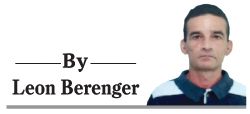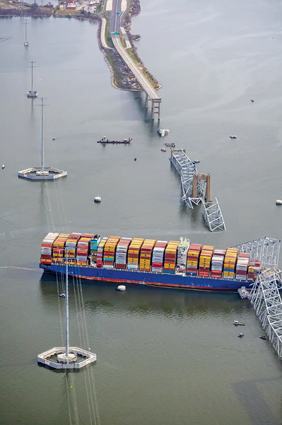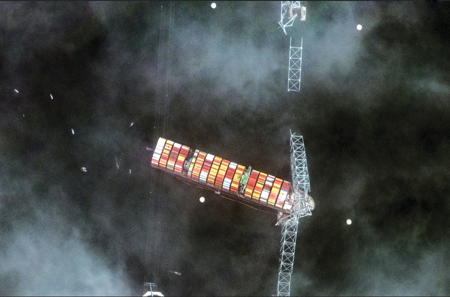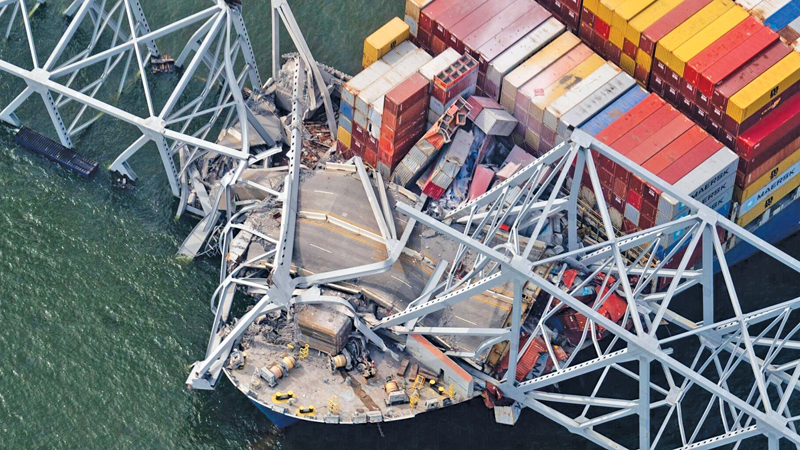- Ship laden with hazardous waste stuck in Baltimore
- Attempt made in late 1980s to unload Diazinon at Colombo Port
- Lone Sri Lankan seafarer on board works as electrical engineer
 International and local maritime trade unions this week expressed serious concern on the well-being of the 21 seafarers on board the Singaporean-flagged Dali that crashed on to the Francis Scott Key Bridge over the Patapsco River in Baltimore-USA on March 26 and called on the authorities to closely monitor the developments both at home and overseas.
International and local maritime trade unions this week expressed serious concern on the well-being of the 21 seafarers on board the Singaporean-flagged Dali that crashed on to the Francis Scott Key Bridge over the Patapsco River in Baltimore-USA on March 26 and called on the authorities to closely monitor the developments both at home and overseas.
International Transport Workers’ Federation (ITF) Colombo Office representative Ranjan Perera told the Sunday Observer that the current focus by the authorities is on the devastation of the crash and the sequence of repercussions such as the loss of jobs and the crippling of the shipping infrastructure in that region.
“But at the same time, we urge the authorities to be mindful on the well-being of the crew on board the vessel which is now known to be carrying several containers of hazardous material and other toxic agents among its load that was scheduled to arrive at the Colombo Port on April 21,” he said.

NUSS President Boa Athu

ITF Colombo Representative Ranjan Perera
It is the crew that will remain the most exposed to such material during the voyage on the high seas and negligence or whatever on the part of the ground handlers to allow such cargo to be loaded on the vessel should be thoroughly investigated and appropriate action taken accordingly,” Perera said.
According to the findings available to the ITF, the generators on the ship had abruptly packed up forcing the vessel to move aimlessly at a speed of some 10 knots on the icy cold waters of the Patapsco River and it was not in a position to change direction and, therefore, it rammed into a supporting tower that saw the bridge collapse like a pack of cards, Perera a former merchant ship Captain said.
Nature of the cargo
He added that the Captain of the vessel should be made aware of the nature of the cargo, hazardous or whatever and he retains the discretion to accept or refuse the cargo for safety reasons.
“It is yet not known if the Captain of the vessel was indeed aware of the hazardous cargo that was being piled on to his ship and that is something for the US investigators to find out.”
The Ports in the US are equipped with the state-of-the-art security equipment for checking cargo and, therefore, it should have been within their capacity and responsibility to have placed a proper and efficient screening procedure before the loading commenced.
The entire crew made up of 21 Indians and a single Sri Lankan are registered with the ITF.
The Sri Lankan identified as Chaminda Kariyawasam was employed on the vessel as the electrical engineer and the ITF has already contacted him via the phone.
He appears to be in very good health, but at the same time is concerned as to how long he would have to remain in the ship until the investigations are completed.
“Apart from the investigations, retrieving the ship from the waters would also take a considerable period of time since the bulk of the bridge lays fallen on the front of the vessel,” according to Perera.
The ITF is an international maritime trade union organisation with a membership of one million seafarers affiliated to 106 countries including Sri Lanka.
Impartial probe
 The National Union of Seafarers Sri Lanka (NUSS) echoed the same concerns of the ITF and also called on the authorities to carry out an impartial probe surrounding the hazardous cargo on the Dali in the interest of the local seafarers.
The National Union of Seafarers Sri Lanka (NUSS) echoed the same concerns of the ITF and also called on the authorities to carry out an impartial probe surrounding the hazardous cargo on the Dali in the interest of the local seafarers.
NUSS President Boa Athu said that it was a dangerous development in the maritime industry and the most vulnerable persons would be the seafarers who would be in constant contact with the vessel’s cargo since it is the nature of their job.
“It would be unfair in more than one way by the seafarers if dangerous materials as in the case of the Dali are allowed to be willingly loaded on to vessels by unscrupulous businesspersons or whatever and the Government should go the whole hog in its probe aimed at bringing the culprit or culprits to book without delay”, Athu said.
The Government this week said it was not aware of any hazardous material on a foreign vessel that was to dock in Colombo on April 22, but at the same time assured that a thorough probe will be conducted to ascertain the identity of the consignee and the purpose.
State Minister for Environment Janaka Wakkumbura told Parliament that the Central Environment Authority had not been informed of any hazardous cargo on the vessel, adding that the Sri Lanka Customs and the Colombo Port have been instructed to carry out a probe.
He was responding to a question from Opposition leader Sajith Premadasa who sought if permission had been granted to unload such cargo at the Colombo Port.
The Port officials said the ship was due to reach Colombo on April 22 and the information on its cargo would only have been known 72 hours prior to its arrival.
The Central Environment Authority officials said its approval was a must even if unloading in Colombo was limited to transshipment of cargo, adding that it was not aware that the Dali was carrying hazardous materials to Sri Lanka
The Leader of the main Opposition Sajith Premadasa said a proper investigation should be conducted as to how such a cargo ship carrying hazardous materials was heading to Sri Lanka without the knowledge of the country.
“We would not have known of the hazardous material in the cargo ship if it did not encounter the crash. A proper investigation should be conducted as to how such a ship was heading to Sri Lanka in such a manner,” Premadasa said.
Minister Wakkumbura said that Sri Lanka would not have known of the hazardous material on the vessel if it had not crashed into the bridge.
Sri Lanka Ports Authority (SLPA) Chairman Keith Bernard had said the ship should declare the contents in the containers 72 hours before the time of arrival into the Colombo Port.
The ship was scheduled to arrive in Colombo on April 21, 2024 and that means the crew should inform the Port authorities on April 18, he had said.
Ports and Shipping Minister Nimal Siripala de Silva, however, said that only a single container on board the vessel was carrying hazardous waste material.
Sri Lankan agent
The Minister was responding to ongoing speculation, noting that the vessel’s Sri Lankan agent had formally communicated these details to the authorities.
 Minister de Silva also said that the 56 containers listed as dangerous cargo were destined for re-export to another country. The Colombo Port was not the final stop for the vessel. The ultimate destination for the ship was China, yet there have been unverified reports indicating otherwise. He said that in accordance with international maritime regulations, detailed shipment declarations are typically made two days prior to reaching the port. Moreover, strict customs inspections precede any unloading activity, ensuring transparency and safety protocols are firmly in place.
Minister de Silva also said that the 56 containers listed as dangerous cargo were destined for re-export to another country. The Colombo Port was not the final stop for the vessel. The ultimate destination for the ship was China, yet there have been unverified reports indicating otherwise. He said that in accordance with international maritime regulations, detailed shipment declarations are typically made two days prior to reaching the port. Moreover, strict customs inspections precede any unloading activity, ensuring transparency and safety protocols are firmly in place.
Minister de Silva said that vessels such as the ‘Dali’ carry general and dangerous cargo. The adherence to established procedures and thorough customs checks guarantee the proper handling of all goods on board before any further action is taken.
According to the most recent US media reports, the waste included mostly corrosives, flammables, miscellaneous hazardous materials, and Class-9 hazardous materials, including explosives and lithium-ion batteries – in 56 containers.
The reports stated that officials from the US National Transportation Safety Board (NTSB), were still ‘analysing the ship’s manifest to determine what was onboard’ in its other remaining 4,644 containers.
Prior to Baltimore, the Dali called at New York and Norfolk, Virginia, which has the world’s largest naval base. Colombo was to be its next scheduled call, going around South Africa’s Cape of Good Hope, taking 27 days, and scheduled to arrive in Colombo after the upcoming Sinhala and Tamil New Year.
Security officials were quoted as saying that to whom exactly the toxic material and fuel were meant in Sri Lanka remains unclear while there are unverified reports in Colombo that a top business house was the alleged consignee.
The crew members are busy with their normal duties on the ship as well as assisting the NTSB and Coast Guard investigators on board,” a NTSBCG spokesperson was quoted by foreign media as saying.
“It is not known as to how long the investigation process will take and until that is complete, the crew will remain on board,” the spokesman was further quoted as saying.
Last week, the US authorities boarded the vessel and interviewed the crew and collected documents, voyage data recorder extracts, and other evidence as part of their investigation.
US President Joe Biden said that the crew on board the Dali had alerted transportation personnel about losing control of the vessel, enabling the authorities to close the Baltimore Bridge to traffic before the devastating collision, “undoubtedly” saving lives.
However, attempts to dump hazardous cargo in Sri Lanka go back to the late 1980s.
It was during that time that a foreign vessel loaded with a hazardous waste material identified as Diazinon – an agriculture pesticide that had outlived its shelf life and turned toxic arrived at the Colombo Port.
Vigorous attempts were made at that time by the consignee and errant State actors to unload the shipment. Arrangements had been made to incinerate it at a land fill in the outskirts of Homagama.
A Sri Lanka media campaign along with inputs from the international environment organisation ‘Green Peace” and other actors finally saw the vessel raise anchor and leave for the UK which was its last port of call.
Exposure to Diazinon, whether from ingestion, skin contact, or inhalation can result in nervous system health effects. These effects may include watery eyes, runny nose, drooling, loss of appetite, coughing, urination, diarrhoea, stomach pain, and vomiting.
As the probe continues to establish the true cause of the crash and above all, the mystery consignee or consignees of the hazardous waste somebody somewhere in this country or elsewhere is holding on to a smoking gun.






